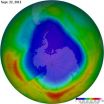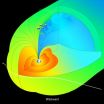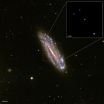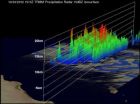(Press-News.org) WASHINGTON -- The average area covered by the Antarctic ozone hole
this year was the second smallest in the last 20 years, according to
data from NASA and National Oceanic and Atmospheric Administration
(NOAA) satellites. Scientists attribute the change to warmer
temperatures in the Antarctic lower stratosphere.
The ozone hole reached its maximum size Sept. 22, covering 8.2 million
square miles (21.2 million square kilometers), or the area of the
United States, Canada and Mexico combined. The average size of the
2012 ozone hole was 6.9 million square miles (17.9 million square
kilometers). The Sept. 6, 2000 ozone hole was the largest on record
at 11.5 million square miles (29.9 million square kilometers).
"The ozone hole mainly is caused by chlorine from human-produced
chemicals, and these chlorine levels are still sizable in the
Antarctic stratosphere," said NASA atmospheric scientist Paul Newman
of NASA's Goddard Space Flight Center in Greenbelt, Md. "Natural
fluctuations in weather patterns resulted in warmer stratospheric
temperatures this year. These temperatures led to a smaller ozone
hole."
The ozone layer acts as Earth's natural shield against ultraviolet
radiation, which can cause skin cancer. The ozone hole phenomenon
began making a yearly appearance in the early 1980s. The Antarctic
ozone layer likely will not return to its early 1980s state until
about 2065, Newman said. The lengthy recovery is because of the long
lifetimes of ozone-depleting substances in the atmosphere. Overall
atmospheric ozone no longer is declining as concentrations of
ozone-depleting substances decrease. The decrease is the result of an
international agreement regulating the production of certain
chemicals.
This year also showed a change in the concentration of ozone over the
Antarctic. The minimum value of total ozone in the ozone hole was the
second highest level in two decades. Total ozone, measured in Dobson
units (DU), reached 124 DU on Oct. 1. NOAA ground-based measurements
at the South Pole recorded 136 DU on Oct. 5. When the ozone hole is
not present, total ozone typically ranges from 240-500 DU.
This is the first year growth of the ozone hole has been observed by
an ozone-monitoring instrument on the Suomi National Polar-orbiting
Partnership (NPP) satellite. The instrument, called the Ozone Mapping
Profiler Suite (OMPS), is based on previous instruments, such as the
Total Ozone Mapping Spectrometer (TOMS) and the Solar Backscatter
Ultraviolet instrument (SBUV/2), which have flown on multiple
satellites. OMPS continues a satellite record dating back to the
early 1970s.
In addition to observing the annual formation and extent of the ozone
hole, scientists hope OMPS will help them better understand ozone
destruction in the middle and upper stratosphere with its Nadir
Profiler. Ozone variations in the lower stratosphere will be measured
with its Limb Profiler.
"OMPS Limb looks sideways, and it can measure ozone as a function of
height," said Pawan K. Bhartia, a NASA atmospheric physicist and OMPS
Limb instrument lead. "This OMPS instrument allows us to more closely
see the vertical development of Antarctic ozone depletion in the
lower stratosphere where the ozone hole occurs."
INFORMATION:
VIDEO:
This video shows the status of the ozone hole between Jul. 1, 2012 to Oct. 19, 2012. The hole reached its maximum on Sept. 22, 2012.
Click here for more information.
NASA and NOAA have been monitoring the ozone layer on the ground and
with a variety of instruments on satellites and balloons since the
1970s. Long-term ozone monitoring instruments have included TOMS,
SBUV/2, Stratospheric Aerosol and Gas Experiment series of
instruments, the Microwave Limb Sounder, the Ozone Monitoring
Instrument, and the OMPS instrument on Suomi NPP. Suomi NPP is a
bridging mission leading to the next-generation polar-orbiting
environmental satellites called the Joint Polar Satellite System,
will extend ozone monitoring into the 2030s.
NASA and NOAA have a mandate under the Clean Air Act to monitor
ozone-depleting gases and stratospheric depletion of ozone. NOAA
complies with this mandate by monitoring ozone via ground and
satellite measurements. The NOAA Earth System Research Laboratory in
Boulder, Colo., performs the ground-based monitoring. The Climate
Prediction Center performs the satellite monitoring.
To monitor the state of the ozone layer above Antarctica, visit:
http://ozonewatch.gsfc.nasa.gov
2012 Antarctic ozone hole second smallest in 20 years
2012-10-25
ELSE PRESS RELEASES FROM THIS DATE:
Plants provide accurate low-cost alternative for diagnosis of West Nile Virus
2012-10-25
While the United States has largely been spared the scourge of mosquito-borne diseases endemic to the developing world—including yellow fever, malaria and dengue fever—mosquito-related illnesses in the US are on the rise. One pathogen of increasing concern in the U.S. is an arbovirus known as West Nile.
Now Qiang "Shawn" Chen, a researcher at Arizona State University's Biodesign Institute and a professor in the College of Technology and Innovation has developed a new method of testing for West Nile, using plants to produce biological reagents for detection and diagnosis. ...
NASA study using cluster reveals new insights into solar wind
2012-10-25
A new study based on data from European Space Agency's Cluster mission shows that it is easier for the solar wind to penetrate Earth's magnetic environment, the magnetosphere, than had previously been thought. Scientists from NASA's Goddard Space Flight Center in Greenbelt, Md. have, for the first time, directly observed the presence of certain waves in the solar wind—called Kelvin-Helmholtz waves that can help transfer energy into near-Earth space—under circumstances when previous theories predicted they were not expected.
The recent paper, published on Aug 29, 2012, ...
Galaxy halos are produced by orphan stars, findings indicate
2012-10-25
Irvine, Calif., Oct. 24, 2012 – Isolated stars kicked to the edges of space by violent galaxy mergers may be the cause of mysterious infrared light halos observed across the sky, according to UC Irvine and other astronomers.
"Background glow in our sky has been a huge unanswered question," said UCI physics & astronomy professor Asantha Cooray, lead author of a paper about the discovery in the Oct. 25 issue of the journal Nature. "We have new evidence that this light is from stars that linger between galaxies. Individually, they're too dim to be seen, but we think we're ...
Video game with biofeedback teaches children to curb their anger
2012-10-25
Boston, Mass. , Oct. 24, 2012—Children with serious anger problems can be helped by a simple video game that hones their ability to regulate their emotions, finds a pilot study at Boston Children's Hospital. Results were published online October 24 in the journal Adolescent Psychiatry.
Noticing that children with anger control problems are often uninterested in psychotherapy, but very eager to play video games, Jason Kahn, PhD, and Joseph Gonzalez-Heydrich, MD, at Boston Children's Hospital developed "RAGE Control" to motivate children to practice emotional control skills ...
NASA satellite shows the Tropical Storm Son-tinh's reach over Philippines
2012-10-25
The latest tropical storm in the western North Pacific Ocean has already spread its clouds and showers over the Philippines, as seen in NASA satellite imagery. NASA's Aqua satellite captured an image as it flew over Tropical Storm Son-tinh today, Oct. 24.
On Oct. 24, 2012 at 0445 UTC (12:45 a.m. EDT) the Moderate Resolution Imaging Spectroradiometer (MODIS) instrument that flies aboard NASA's Aqua satellite captured a visible image of Tropical Storm Son-tinh. At the time of the image, Son-tinh's center was moving through the central Philippines, but its cloud cover extended ...
Revealing a mini-supermassive black hole
2012-10-25
One of the lowest mass supermassive black holes ever observed in the middle of a galaxy has been identified, thanks to NASA's Chandra X-ray Observatory and several other observatories. The host galaxy is of a type not expected to harbor supermassive black holes, suggesting that this black hole, while related to its supermassive cousins, may have a different origin.
The black hole is located in the middle of the spiral galaxy NGC 4178, shown in this image from the Sloan Digital Sky Survey. The inset shows an X-ray source at the position of the black hole, in the center ...
NASA's TRMM satellite sees birth of Arabian Sea cyclone
2012-10-25
NASA's TRMM satellite measured rainfall and towering clouds within the Arabian Sea's first tropical cyclone of the season as it passed overhead from space. Meanwhile, the infrared AIRS instrument aboard NASA's Aqua satellite noticed that strong thunderstorms surrounded the center of the storm. Tropical Cyclone 1A is expected to be short-lived as it heads for a landfall in Somalia on Oct. 25.
Since it was launched in 1997 the Tropical Rainfall Measuring Mission (TRMM) satellite has been useful for monitoring tropical cyclones in the tropics. TRMM passed above the first ...
Moderate drinking decreases number of new brain cells
2012-10-25
Drinking a couple of glasses of wine each day has generally been considered a good way to promote cardiovascular and brain health. But a new Rutgers University study indicates that there is a fine line between moderate and binge drinking – a risky behavior that can decrease the making of adult brain cells by as much as 40 percent.
In a study posted online in the journal Neuroscience, scheduled to be published on November 8, lead author Megan Anderson, a graduate student working with Dr. Tracey J. Shors, Professor II in Behavioral and Systems Neuroscience in the Department ...
Study shows whites twice as likely as blacks to get CPR from bystanders
2012-10-25
AURORA, Colo. (Oct. 24, 2012) – In the first study of its kind, researchers have found that those who suffer cardiac arrests in upper income, white neighborhoods are nearly twice as likely to get cardiopulmonary resuscitation (CPR) than people who collapse in low-income, black neighborhoods.
"If you drop in a neighborhood that is 80 percent white with a median income over $40,000 a year, you have a 55 percent chance of getting CPR," said study author Comilla Sasson, MD, an emergency room physician at the University of Colorado Hospital. "If you drop in a poor, black neighborhood ...
Reclaiming rare earths
2012-10-25
Recycling keeps paper, plastics, and even jeans out of landfills. Could recycling rare-earth magnets do the same? Perhaps, if the recycling process can be improved.
Scientists at the U.S. Department of Energy's (DOE) Ames Laboratory are working to more effectively remove the neodymium, a rare earth element, from the mix of other materials in a magnet. Initial results show recycled materials maintain the properties that make rare-earth magnets useful.
The current rare earth recycling research builds on Ames Laboratory's decades of rare-earth processing experience. In ...






